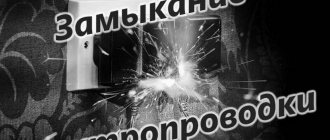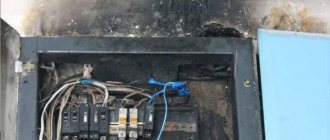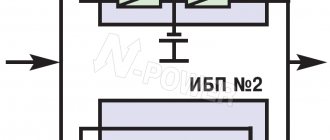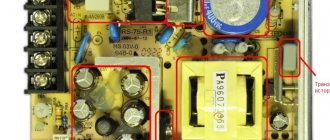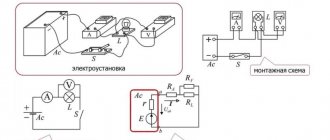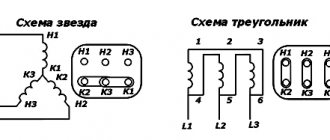A short circuit (short circuit) is understood as a special case when 2 conductors of electric current of different potentials or phases of an electrical device are connected to each other or to the ground. At the junction of the conductors, there is a sharp increase in the value of the electric current, exceeding the maximum permissible parameter. This leads to a stop in the normal functioning of the device and adjacent elements.
According to a simplified formulation, the presented type of circuit is any abnormal and unplanned connection of electrical conductors having different potential values. These can be, for example, phase and zero, which leads to the formation of destructive currents.
The phenomenon is dangerous to human health and property. A short circuit causes not only equipment failure, but also stops the operation of electrical appliances. If you neglect safety rules, this could potentially result in complete failure of the devices or their individual parts with the impossibility of restoration. Fire may also occur, leading to detrimental consequences for human life, property and the environment.
Short circuit current calculation
To understand why this process occurs, it is necessary to calculate the values of short circuit currents. To do this, you need to know Ohm's law: “The value of the current in a certain gap in the electrical circuit is directly proportional to the voltage value and inversely proportional to the current resistance in this gap.” This is a fundamental law of electricity, which is studied even in the school curriculum. For greater clarity, it should be denoted by the formula: I=U/R, where:
- I - current strength;
- U is the voltage on the circuit section;
- R - resistance.
Any electrical equipment connected to a domestic or industrial electrical circuit is an active resistance. The voltage setting for the household network is 220 V (in some cases 230 V). The value presented is unchanged. The higher the resistance value of a device (conductor or some material) connected to the power supply, the lower the amount of electric current will be.
To calculate short-circuit current, it is better to use a more advanced form of Ohm's law, called Ohm's law for a complete circuit.
This form of Ohm's law is also studied in the school curriculum, but few people remember about it. But it is precisely this that is used to calculate short-circuit current. The fact is that if the resistance of the external elements of the circuit is 0, then a strange division by zero will not appear, but instead the current will be quite specifically and accurately calculated as a result of dividing the emf of the source by the internal resistance of the voltage source:
Ikz=ε / r
Of course, if a short circuit occurs in a house or apartment, the current passes through the wiring from the point of the short circuit to the point at which the EMF occurs. And it doesn’t matter whether the wires are copper or made of aluminum - they have resistance. And in this case R is not equal to zero. What is it equal to - read on.
Example 1. Network with voltage 220–230V
Let's take for a specific example: a wiring length of 100 m and a wire cross-sectional area of 2.5 mm² and then let's see what their resistance will be if they are made of copper.
The formula, also known from the physics textbook of any high school, reads:
R=ρ·L/S,
Where:
ρ is the resistivity of copper, equal to approximately 0.017–0.018 Ohm mm²/m;
L is the length of the conductor, expressed in meters;
S is the area of the conductor, expressed in mm².
Let’s take into account that there are not one, but two wires supplying electricity (the current comes in through one wire and leaves through the second), so the length of the wire L doubles in the calculation:
R =0.018·2·100/2.5= 1.44 Ohm
So, now you can see that the wires have a fairly high resistance. To now estimate the short-circuit current, you can use Ohm's law. We do not know the internal resistance of the power source, but as can be seen from the formula of Ohm’s law for a complete circuit, the greater it is, the less the short-circuit current will be. Therefore, taking r=0 we will find the maximum possible short-circuit current with the calculated R=1.44 Ohm .
We also assume that the supply voltage in the network is also the maximum possible, and is 230 + 10% = 253 V. In this case, the short circuit current will be equal to:
Ikz = 253/1.44 = 175.7 A
So, we carried out the calculation for a specific supply conductor. For postings with other parameters, the calculation can be done in a similar way.
Example 2: Battery
If a short circuit occurs directly at the EMF source (we can encounter this phenomenon in the case of a “short” household or car battery or power battery), then in this case the external resistance R≈0. Therefore, for the calculation we will need to know the internal resistance r as accurately as possible (otherwise, division by zero will occur again and we will not count anything worthwhile). Calculating it is not difficult if you have a resistance (resistor) and a multimeter.
Now let's look at a specific example. Let's say we have a 12V car battery. How to proceed to determine its short-circuit current.
We will need a 10 Ohm 15W resistor, which will help us perform the necessary experiment:
- We measure the battery supply voltage in idle mode (without load) with a multimeter, let’s say we get a value of 11.85 V.
- Next, we connect a 10 Ohm 15W resistor as a load and measure the current with a multimeter. We got 1.07 A.
- Without disconnecting the 100 Ohm resistor, we measure the voltage drop across the battery terminals. Let it be 10.8 V.
- Now you can calculate the internal resistance: r = 11.85–1.07 10.8 = 0.3 Ohm.
- Now you can determine the short-circuit current: Ikz = 11.85/0.3 = 39.5 A
If you haven’t yet guessed what formulas were used, here are some hints:
r=Uхх–In·Un,
Iкз=Uхх/r,
Where:
Uхх — open-circuit voltage of the power supply;
Iн is the current supplied by the power source under load;
Un is the voltage of the power source under load.
As can be seen from the formulas, the load value itself does not need to be known, however, it is selected in such a way that the measurement error of the device does not give too large a scatter in the result (if the load slightly “drains” the voltage of the power source, that is, Uхх ≈ Un , then the accuracy the result will be extremely low).
How does the process work?
Everything seems to happen instantly. Something hummed, the light dimmed and then went out. In fact, like any physical phenomenon, the process can be mentally stretched, slowed down, analyzed and divided into phases. Before the onset of an emergency, the circuit is characterized by a steady current value that is within the rated mode. Suddenly the total resistance drops sharply to a value close to zero. Inductive components (electric motors, chokes and transformers) of the load seem to slow down the process of current growth. Thus, in the first microseconds (up to 0.01 sec), the short circuit current of the voltage source remains practically unchanged and even decreases slightly due to the onset of the transient process. At the same time, its EMF gradually reaches zero value, then passes through it and is established at some stabilized value, ensuring the occurrence of a large I short circuit. The current itself at the moment of the transient process is the sum of periodic and aperiodic components. The shape of the process graph is analyzed, as a result of which it is possible to determine a constant value of time, depending on the angle of inclination of the tangent to the acceleration curve at the point of its inflection (the first derivative) and the delay time, determined by the value of the reactive (inductive) component of the total resistance.
Causes of short circuit
Now let's briefly look at the possible causes of short circuits.
Common causes of short circuits are as follows:
- outdated wiring;
- mechanical damage inside the circuit;
- improper organization of electrical wires;
- violation of the rules for operating an electrical appliance;
- uncontrolled increase in the power indicator of devices;
- non-compliance with construction standards.
Negative impact of short circuit for a person and his property
A short circuit, depending on the location of its occurrence, leads to detrimental consequences for property and the safety of human life. These include:
- burning and failure of electrical appliances;
- ignition of electrical wiring;
- a decrease in the voltage of the electrical network (in industrial conditions it leads to a shutdown of enterprises);
- decrease in the efficiency of power supply systems;
- the occurrence of electromagnetic influence leads to disruption of the functioning of communications located underground.
Types of short circuit
Electricity is used everywhere in both the domestic and industrial sectors. To reduce the risk of a short circuit to a minimum, a number of measures and devices have been developed to provide protection against short circuits. However, in order to accurately understand in which case and which device to use, you need to know the types of circuits. The main ones are:
- in DC circuits;
- in AC circuits (between: phase and ground, two different phases, three phases, two different phases and ground, three phases and ground).
The share of single-phase short circuits is 65% of damage, 2 phases with earth - 20%, two-phase - 10%, three-phase - 5%. Complex types of damage often occur, accompanied by multiple asymmetries. This means a type of closure of various phases that occurs at several points at the same time.
Scheme
Another way to study the principle of current action is to build a circuit. At the moment, you can use a special program for this. Thanks to it, you can not only understand in what situation a short circuit will occur, but also try to prevent it by building the correct electrical circuit and then using high-quality materials.
Note! It is worth pointing out that in addition to the remote method, it is possible to make the circuit yourself using the appropriate tutorials. As a result of this action, it is possible to check the input circuit breaker, which has an average rated current for the switching capacity in the power cable line. Thanks to the circuit, it will be easy to determine in current values.
Electric current diagram
In general, short-circuit electric current is destructive energy, which depends on the number of photons, emission spectrum, optical properties, and other things. Its power can be measured using a special formula. It has its own schedule and diagram, which are presented above.
Short circuit search methods
Finding the location of this phenomenon in advance is quite difficult. In most cases, neither specialists nor ordinary users care about it. However, this will help neutralize it in time, which will make it impossible for harmful consequences to occur. Thanks to timely response, financial resources and time are saved. There are several methods for determining a short circuit:
- visual inspection of the wiring (there should be no breaks or exposed wires);
- using a multimeter or megohmmeter;
- by sound;
- exception.
Wires that are part of a live cable may come into contact with each other. If they are exposed, then this is the obvious cause of the short circuit. Such damage is usually found in junction boxes and other power supply units (sockets, switches, etc.). Burnt cable insulation is an obvious place where a short circuit could potentially form.
The use of special instruments helps to measure the resistance value of the circuit. They contain 2 wires: one of them is connected to the phase, and the other to zero (hereinafter referred to as ground). If the device display shows 0, then the wiring integrity is normal, if any other value, the contacts are in contact. Please note that the multimeter voltage is quite small. It can be used to measure chains no more than 3 meters long.
Finding the location of a short circuit by sound is a popular method for determining this phenomenon. To do this, you need to listen carefully at all connections. A characteristic cracking sound will be heard at the point of contact. Sometimes there is a smell of burnt plastic and insulation. This method of finding short circuits should be used only as a last resort when other methods are unavailable.
It often happens that the culprit is a connected electrical appliance. Turning it on will immediately trip the fuse. This will lead to an immediate shutdown of the power supply to the area. You can find such a device by elimination, turning on all devices one by one.
Experts strongly recommend not to use outdated methods of searching for short circuits. In most cases, they do not show proper accuracy and efficiency. If there is a need to find a short circuit location, it is necessary to invite professionals who will use high-quality and accurate equipment.
What it is
This is an electrical connection of several points in an electrical circuit that have different potential values that are not provided for by the design of the device and interfere with its normal functioning. It is also called a sharply increasing shock electric pulse. Occurs if the insulation in current-carrying elements has been broken or mechanical contact of uninsulated conductors has occurred. This also happens when the load resistance value is less than that of the power source.
Full Definition
Short circuit protection
There are various devices for short circuit protection:
- circuit breakers;
- circuit breakers with automatic return to the on state;
- RCD;
- fuses;
- "traffic jams";
- self-resetting fuses.
The presented circuit involves a zener diode and diodes that protect the LEDs from the effects of reverse currents. 2 resistors are responsible for limiting the current in the protection system. The fuse must be of a self-resetting type; the ratings of the elements must be selected individually depending on the conditions.
An effective way to protect against this phenomenon is to use a current-limiting reactor. It is used in electrical circuit protection systems, where the magnitude of the short circuit can be of such a magnitude that conventional equipment cannot cope with.
The rector has the form of a coil with an inductive type resistance, connected to the network in a series circuit. Acceptable circuit operation allows the reactor voltage drop to be maintained at around 4%. When a short circuit occurs, the main part of the voltage is supplied to this device. Such equipment comes in oil and concrete types. Each of them is used depending on the type of electrical wiring and the equipment it powers.
Protective and preventive measures
It is almost impossible to completely protect against short circuits, since in many cases it occurs under the influence of random factors. Therefore, the main role is given to preventive measures, which determines the reduction in the likelihood of emergency situations.
The following must be planned and implemented:
- Monitoring and determining the condition of the insulating layer of live parts of electrical installations or power lines. In industrial premises, wire insulation is tested once every 3 years or more often. Home networks are standardized by terms of maximum operation. For example, hidden wiring made of copper wire can be used for 40 years.
- Before you find hidden wiring before drilling into walls, you need to check the electrical circuit diagram or design in advance. This will significantly reduce the likelihood of damage, although more accurate results can only be obtained using a special search device.
- When leaving home, you should turn off all electrical appliances, especially powerful equipment - heaters, electric stoves, dishwashers, etc.
- In rooms where there are signs of high humidity, the number of electrical devices should be kept to a minimum. It is permissible to operate devices only with the appropriate protection class.
- Damaged electrical equipment should not be connected to the network.
- Do not go beyond the established norms for electricity consumption.
Useful short notice
The current arising due to such a phenomenon can bring not only destruction, but also benefit. There are a number of equipment that operate under conditions of increased current. A classic example of such devices is electric arc welding. Its operation is due to the connection of the welding electrode and the ground loop.
Under significant overloads, the functioning of such devices is short-lived. It is provided by a high-power welding transformer. In the place where the 2 electrodes come into contact, a fairly significant current is generated. This leads to the release of a large amount of thermal energy, which is sufficient to melt the metal in the contact area. This process ensures welding operation. The seam is neat, durable and strong.
Use of this phenomenon
This phenomenon has found its application in arc welding, the operating principle of which is based on the interaction of a rod with a metal surface. The surface is heated to the melting temperature, due to which a new strong connection appears, i.e. the welding electrode is closed with the grounding circuit.
Such short circuit modes operate for a short period of time. At the time of welding, a non-standard current charge arises at the junction of the rod and the surface, due to which a large amount of heat is released. It is enough to melt metal and create a weld.
Short circuits are also used in the field of industrial automation; with its help, information systems are created that reflect the parameters of current signal transmission.
Useful short circuit is used in electrodynamic sensors. For example, in induction vibrometers, seismic receivers. A short circuit makes it possible to further reduce the number of oscillations of the moving system.
Short-circuit mode can be used when combining stages in electronics, when the output of the first active component operates in short-circuit mode.
